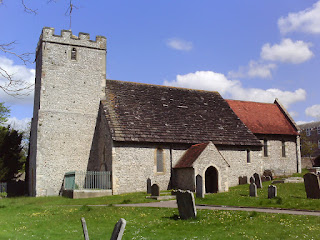 |
| St Nicolas Church Portslade |
About 900 years ago, the people of Portslade decided to build their own church. It was a little Norman church situated on a hill on the eastern side of the Old Village, overlooking the Channel. It became a landmark to sailors and was appropriately dedicated to St Nicolas, Patron Saint of Sailors.
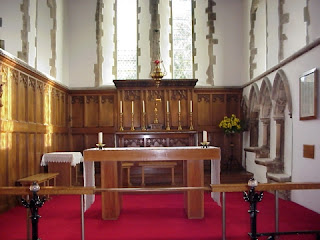 |
| The Altar |
The Altar, A table made of wood or stone, and consecrated by a Bishop, on which the bread and wine is placed for celebration of the Eucharist. The Altar is situated in the Chancel or Sanctuary. This area is usually reserved for Clergy and Servers, The people enter this area to receive Holy Communion or a Blessing during the most solemn part of the Eucharist
 |
| The Nave |
The Nave, This is the part of the Church where people sit. The term is generally thought to come from the Latin word "navis", a ship. Christians in early times have thought of the Church as being a ship which carries them safely across the seas of life
 |
| The Font |
The Font, A large bowl-shaped object in the Baptistery, which holds the water used in Baptism. The outward and visible sign in Baptism is the use of water in the name of the Trinity; the inward and spiritual is the indwelling of the Holy Spirit within us.
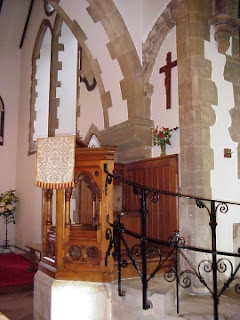 |
| The Pulpit |
The Pulpit, This is where sermons are preached by the Clergy, and readings from the Holy Bible are made to the people
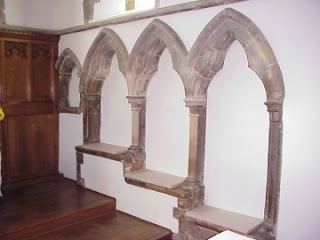 |
| Sedilia and Piscina |
Sedilia, These are seats for the Priests on the south side of the Chancel and date from the 13th Century.
Piscina, This is the small arched recession to the east of the three seats, it is a stone dish with basin used for ablutions at Mass.
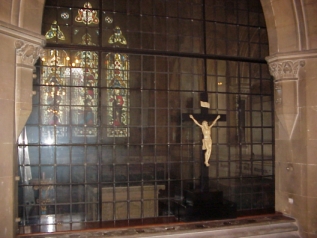 |
| Brackenbury Chapel |
The Brackenbury Chapel dates from 1869, It can be seen through the west wall window in the north aisle. Hannah Brakenbury, who founded the St Nicolas Church School in Locks Hill in 1872, is buried here
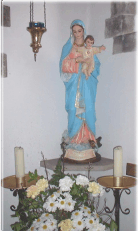 |
| The Blessed Virgin Mary and Child |
The statue of the Blessed Virgin Mary and Child was presented to the Parish by the Nuns of the Roman Catholic Order of The Poor Servants of The Mother of God, of the former St Marye's Convent (now Emmaus Brighton & Hove) who were neighbours of St Nicolas Church for 90 years
 |
| St Francis of Assisi |
A small stained glass window depicting St Francis of Assisi can be seen in the east wall St Francis is the Patron Saint of ecologists and merchants
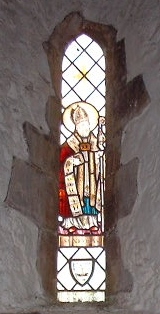 |
| St Nicolas |
St Nicolas is depicted in a stained glass window in the baptistery high on the west wall of the tower
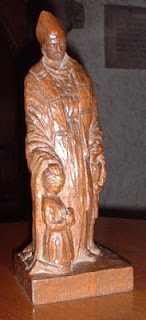 |
| Wood Carving of St Nicolas |
A wood carving of St Nicolas on the font cover
A tiled mural depicting St Nicolas was originally on the west wall of St Nicolas C of E Primary School, Portslade; unfortunately it had to be removed in 2013 for safety reasons.
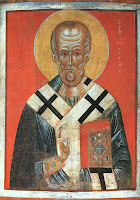 |
| St Nicolas of Myra |
In the 4th century, St Nicolas was bishop of Myra in Lycia, which is now part of Turkey. Nicolas was born into a wealthy family and devoted his inheritance to works of charity, especially towards children.
There are many miracles and legends associated with Nicolas’s life. The “three purses” shown in pictures of St Nicolas are the three bags of gold that Nicolas provided as a dowry for three young women, to save them from being sold into slavery. There is little documentary evidence for the life of St Nicolas that survives today.
The universal popularity of the saint for so many centuries indicates the profound effect his life and example had on the early church.
Scholars of Church Art have noted that Christian artists have represented St.Nicolas more frequently than any other saint except for the Blessed Virgin Mary.
St Nicolas/Nicholas is the Patron Saint, of Bakers, Brewers, Brides, Captives, Children, Coopers, Mariners, Merchants, Pawnbrokers, Sailors, and also the countries of Greece and Russia,
St Nicolas Day is celebrated on the 6th December.













